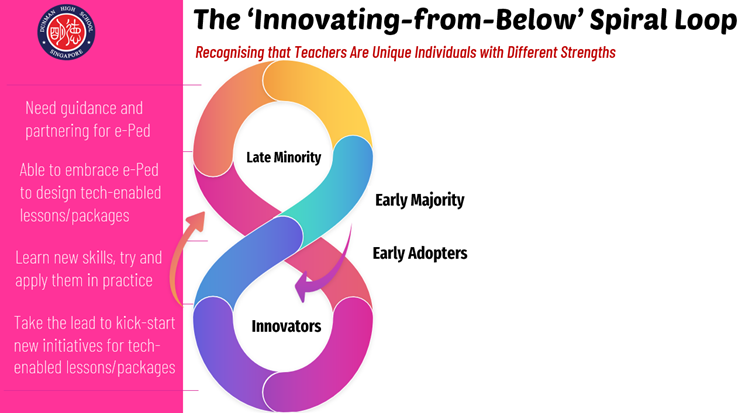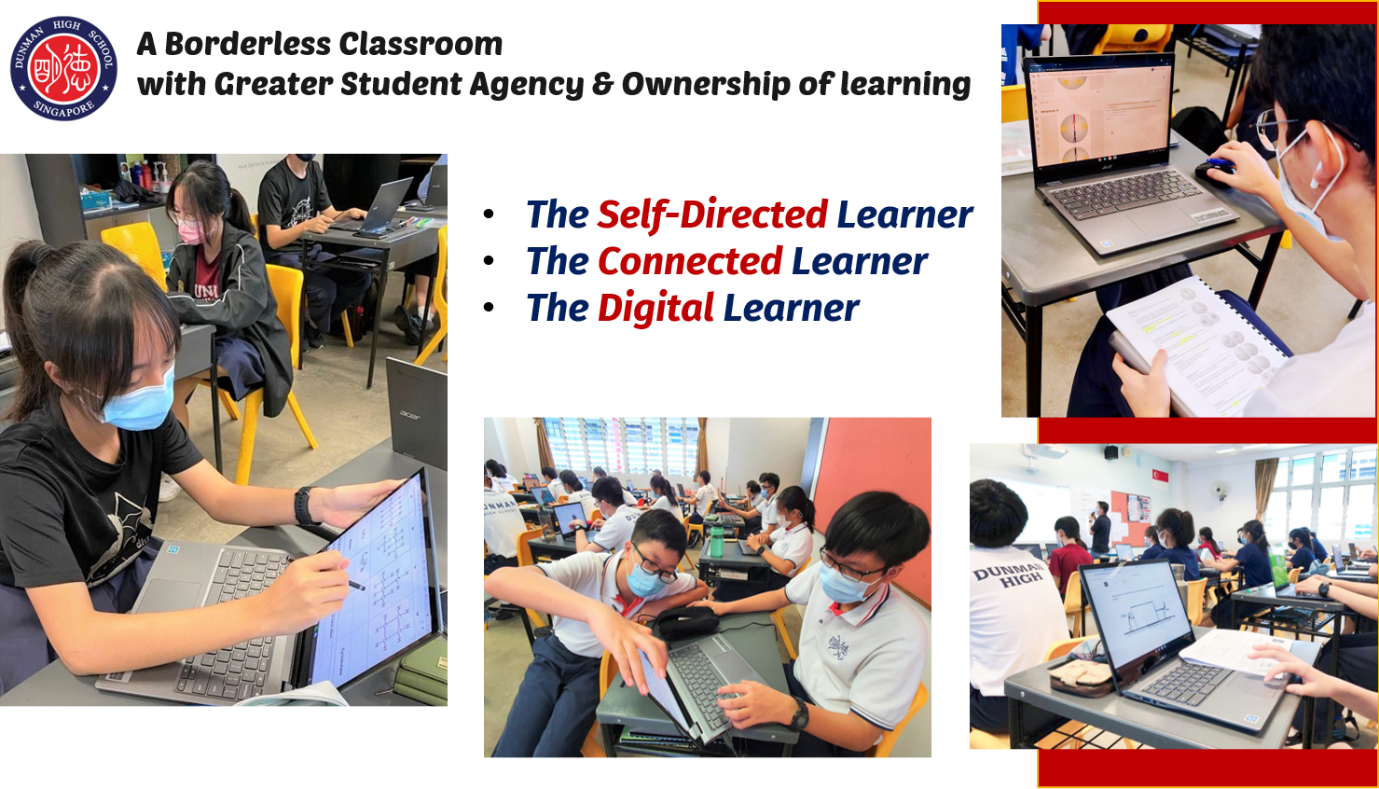Why Singapore’s English Teachers Should Embrace Singlish, Not Fight It
Is it time for Singaporean educators to embrace Singlish as a legitimate learning tool? What the Research […]
Read More
Contributed by Ho Su Siew and Tan Chih Yuan, Dunman High School, for SingTeach Virtual Staff Lounge
Over the past decade, there is an increasing need to raise students’ digital literacy to better enable them to thrive in an increasingly digitalized world. Schools face wide-ranging challenges in doing so and Dunman High School (DHS) is no exception.
To overcome these challenges, DHS embarked on a series of initiatives since 2016 to better equip teachers with the necessary competencies. To nurture future-ready and responsible digital learners, technology is used productively for quality learning in support of the total curriculum. These include authentically shifting the classroom learning culture by integrating technologies into teaching and learning (T&L) in curriculum, pedagogy and assessment, and changing the traditional mindset of teachers to leverage e-Pedagogy regularly in lessons.
In the initial years from 2017 to 2019, a small group of teachers laid the foundation to form DHS’s first EduTech ICT Team, acting as “change agents” to resolve minor ICT-related issues. Gradually, this team grew in numbers, capabilities and passion, solving more complex issues, and creating buy-ins and acceptance. It eventually re-established itself as the DHS Tech for T&L (TfL) Team with a greater readiness.
To this day, the DHS TfL Team continues to pioneer new ICT platforms and digital tools to impact others to embrace technology, and identify emerging technologies to chart new grounds. The bite-sized e-newsletters, TechNews@DHS and Back to School Tips & Tricks@DHS (Figure 1), curated by the team, focuses on different EdTech themes, connecting teachers with tech news, tips and tricks to navigating and staying relevant with emerging technologies.

Figure 1. The Bite-sized e-Newsletters – TechNews@DHS and Back to School Tips & Tricks@DHS.
In 2020, unprecedented disruptions and challenges to the educational landscape due to the pandemic brought about a new normal to T&L. With the launch of the MOE National Digital Literacy Programme for Singapore schools and Institutes of Higher Learning to help students strengthen their digital literacy, every secondary student will own a school-prescribed Personalised Learning Device (PLD) with the introduction of the Personalised Digital Learning Programme (or PDLP).
To develop students as self-directed, connected and digital learners, DHS takes a dynamic and interactive approach to empower teachers to rethink the boundaries of the current academic practices in making Blended Learning a key feature of students’ active learning experiences.
With the focus “Technology Empowered Teaching for Enriched Learning”, DHS PDLP is a 6-year programme where the school continuously refines and sharpens its T&L practices in a tech-enabled environment with its team of dedicated teachers for Year 1 to 6 students.
Recognizing that teachers are at the heart of any pedagogical design as they understand their students’ psychological and learning needs best, DHS taps into every teacher’s full range of skills and expertise to contribute to students’ learning where teachers
The DHS TfL Team paves the way for how technology can amplify effective teaching practices. The team curates content and fronts EdTech workshops collaboratively with the DHS Department ICT Champions, forming the two parallel arms of support for Professional Development (PD) for e-Pedagogy, championing T&L innovations (Figure 2).

Figure 2. The DHS Edutech Gathering where the Dept ICT Champions learnt from the DHS TfL Team to amplify and deepen learning with e-Pedagogy.
Given more autonomy to drive innovations in their departments and subjects, the DHS Department ICT Champions, with expanded roles as the “e-Pedagogy Gurus” and “Tech-Savvy Geniuses”, develop ground-up initiatives and lead the facilitation of school-wide department-based EdTech Meetup to harness technology. They devise win-win strategies to involve department teachers in start-ups, integrating department-specific tech tools in lesson design and portals for T&L. As a community, they share good practices and shape one another’s work during the DHS EduTech Gathering Updates and Showcase for all Department ICT Champions.
At DHS, everyone is a team and is a creator or a co-creator in our journey to embrace ICT in Education. Supporting teachers of diverse tech-entry points through a series of initiatives to equip, level-up and enhance digital competencies, DHS PDLP provides and empowers teachers with the confidence, skills, knowledge and attitude to harness technology in
The process is characterized by the “Innovating-from-Below” Spiral Loop (Figure 3), where the process starts small from the bottom from the group of teachers called the “Innovators”. It then broadens its size and scope around the bends when the “Early Adopters” and “Early Majority” join. The ultimate success comes about when the “Late Minority” are also “influenced” and be part of the flow.
The process is fluid as teachers tend to ‘influence’ one another to learn new skills at any time. Roles can be reversed as more join with their abundant wealth of experiences and knowledge. There can also be times that the “Late Minority” would possess pedagogical skills that can inspire the “Innovators” or “Early Adapters”. Hence, teachers who work together learn from one another and are more successful in improving student outcomes than those who journey alone.

Figure 3. The DHS “Innovating-from-Below” Spiral Loop.
Promoting technology-empowered teaching for enriched learning is a continuous journey of cognitive reframing, supporting and mentoring teachers to embrace tech-empowered T&L, shaping one another’s practices to grow and glow together (Figure 4).

Figure 4. With the skilful use of e-Pedagogy, students’ learning can take place digitally where they become connect, engage and motivate in the classroom and beyond.
Building on the foundation of experimentation which gradually evolves into a structural framework where ideas in tech-empowered T&L are generated and refined, the collaborative innovations of different teams bring the school together to create a borderless classroom with greater student agency and ownership of learning. Teachers have become more skilful in designing tech-enabled lessons as they utilise physical spaces to complement digital spaces to create seamless active learning experiences for students. Students have also become more competent in applying digital literacy skills, using their PLDs more regularly in the classroom and beyond as they derive joy and satisfaction in their learning.